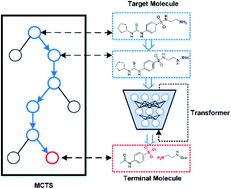当前位置:
X-MOL 学术
›
Chem. Sci.
›
论文详情
Our official English website, www.x-mol.net, welcomes your feedback! (Note: you will need to create a separate account there.)
Automatic retrosynthetic route planning using template-free models
Chemical Science ( IF 8.4 ) Pub Date : 2020/03/03 , DOI: 10.1039/c9sc03666k Kangjie Lin 1, 2, 3, 4, 5 , Youjun Xu 1, 2, 3, 4, 5 , Jianfeng Pei 3, 4, 5, 6, 7 , Luhua Lai 1, 2, 3, 4, 5
Chemical Science ( IF 8.4 ) Pub Date : 2020/03/03 , DOI: 10.1039/c9sc03666k Kangjie Lin 1, 2, 3, 4, 5 , Youjun Xu 1, 2, 3, 4, 5 , Jianfeng Pei 3, 4, 5, 6, 7 , Luhua Lai 1, 2, 3, 4, 5
Affiliation

|
Retrosynthetic route planning can be considered a rule-based reasoning procedure. The possibilities for each transformation are generated based on collected reaction rules, and then potential reaction routes are recommended by various optimization algorithms. Although there has been much progress in computer-assisted retrosynthetic route planning and reaction prediction, fully data-driven automatic retrosynthetic route planning remains challenging. Here we present a template-free approach that is independent of reaction templates, rules, or atom mapping, to implement automatic retrosynthetic route planning. We treated each reaction prediction task as a data-driven sequence-to-sequence problem using the multi-head attention-based Transformer architecture, which has demonstrated power in machine translation tasks. Using reactions from the United States patent literature, our end-to-end models naturally incorporate the global chemical environments of molecules and achieve remarkable performance in top-1 predictive accuracy (63.0%, with the reaction class provided) and top-1 molecular validity (99.6%) in one-step retrosynthetic tasks. Inspired by the success rate of the one-step reaction prediction, we further carried out iterative, multi-step retrosynthetic route planning for four case products, which was successful. We then constructed an automatic data-driven end-to-end retrosynthetic route planning system (AutoSynRoute) using Monte Carlo tree search with a heuristic scoring function. AutoSynRoute successfully reproduced published synthesis routes for the four case products. The end-to-end model for reaction task prediction can be easily extended to larger or customer-requested reaction databases. Our study presents an important step in realizing automatic retrosynthetic route planning.
中文翻译:

使用无模板模型的自动综合路线规划
可以将逆合成路线规划视为基于规则的推理程序。根据收集的反应规则生成每次转化的可能性,然后通过各种优化算法推荐潜在的反应路线。尽管在计算机辅助逆向合成路线规划和反应预测方面取得了很大进展,但是完全由数据驱动的自动逆向合成路线规划仍然具有挑战性。在这里,我们提出了一种无模板的方法,该方法独立于反应模板,规则或原子映射,从而实现了自动合成路线规划。我们使用基于多头注意力的Transformer架构将每个反应预测任务视为一个数据驱动的序列到序列问题,这已经证明了机器翻译任务的强大功能。利用美国专利文献中的反应,我们的端到端模型自然地结合了分子的全球化学环境,并在top-1预测准确性(63.0%,提供了反应类别)和top-1分子有效性方面实现了卓越的性能(99.6%)进行单步逆向合成任务。受到一步反应预测成功率的启发,我们进一步对四个案例产品进行了迭代,多步逆向合成路线规划,并获得了成功。然后,我们使用具有启发式评分功能的蒙特卡罗树搜索构建了一个自动数据驱动的端到端逆向合成路线规划系统(AutoSynRoute)。AutoSynRoute成功地复制了四个案例产品的已发布的合成路线。反应任务预测的端到端模型可以轻松扩展到更大的或客户要求的反应数据库。我们的研究提出了实现自动逆合成路线规划的重要一步。
更新日期:2020-03-26
中文翻译:

使用无模板模型的自动综合路线规划
可以将逆合成路线规划视为基于规则的推理程序。根据收集的反应规则生成每次转化的可能性,然后通过各种优化算法推荐潜在的反应路线。尽管在计算机辅助逆向合成路线规划和反应预测方面取得了很大进展,但是完全由数据驱动的自动逆向合成路线规划仍然具有挑战性。在这里,我们提出了一种无模板的方法,该方法独立于反应模板,规则或原子映射,从而实现了自动合成路线规划。我们使用基于多头注意力的Transformer架构将每个反应预测任务视为一个数据驱动的序列到序列问题,这已经证明了机器翻译任务的强大功能。利用美国专利文献中的反应,我们的端到端模型自然地结合了分子的全球化学环境,并在top-1预测准确性(63.0%,提供了反应类别)和top-1分子有效性方面实现了卓越的性能(99.6%)进行单步逆向合成任务。受到一步反应预测成功率的启发,我们进一步对四个案例产品进行了迭代,多步逆向合成路线规划,并获得了成功。然后,我们使用具有启发式评分功能的蒙特卡罗树搜索构建了一个自动数据驱动的端到端逆向合成路线规划系统(AutoSynRoute)。AutoSynRoute成功地复制了四个案例产品的已发布的合成路线。反应任务预测的端到端模型可以轻松扩展到更大的或客户要求的反应数据库。我们的研究提出了实现自动逆合成路线规划的重要一步。



























 京公网安备 11010802027423号
京公网安备 11010802027423号